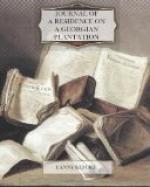with their owner’s mode of living. In all
establishments whatever, of course some disparity
exists between the accommodation of the drawing-rooms
and best bed-rooms and the servants’ kitchen
and attics; but on a plantation it is no longer a
matter of degree. The young women who performed
the offices of waiting and housemaids, and the lads
who attended upon the service of their master’s
table where I lived, had neither table to feed at
nor chair to sit down upon themselves; the ‘boys’
lay all night on the hearth by the kitchen fire, and
the women upon the usual slave’s bed—a
frame of rough boards, strewed with a little moss off
the trees, with the addition perhaps of a tattered
and filthy blanket. As for the so-called privilege
of marrying—surely it is gross mockery to
apply such a word to a bond which may be holy in God’s
sight, but which did not prevent the owner of a plantation
where my observations were made from selling and buying
men and their so-called wives and children into divided
bondage, nor the white overseer from compelling the
wife of one of the most excellent and exemplary of
his master’s slaves to live with him—nor
the white wife of another overseer, in her husband’s
temporary absence from the estate, from barbarously
flogging three married slaves within a month
of their confinement, their condition being the result
of the profligacy of the said overseer, and probably
compelled by the very same lash by which it was punished.
This is a very disgusting picture of married life
on slave estates: but I have undertaken to reply
to the statements of your informant, and I regret
to be obliged to record the facts by which alone I
can do so. ‘Work,’ continues your
authority, ’began at six in the morning, at
nine an hour’s rest was allowed for breakfast,
and by two or three o’clock the day’s work
was done.’ Certainly this was a pattern
plantation, and I can only lament that my experience
lay amid such far less favourable circumstances.
The negroes among whom I lived went to the fields
at daybreak, carrying with them their allowance of
food, which toward noon, and not till then, they ate,
cooking it over a fire which they kindled as best
they could where they were working; their second
meal in the day was at night after their labour was
over, having worked at the very least six hours
without rest or refreshment, since their noon-day
meal—properly so called, indeed, for it
was meal and nothing else, or a preparation something
thicker than porridge, which they call hominy.
Perhaps the candid observer, whose report of the estate
he visited appeared to you so consolatory, would think
that this diet contrasted favourably with that of
potato and butter-milk fed Irish labourers. But
a more just comparison surely would be with the mode
of living of the labouring population of the United
States, the peasantry of Ohio, Pennsylvania, and Massachusetts,
or indeed with the condition of those very potato
and butter-milk fed Irishmen when they have exchanged




